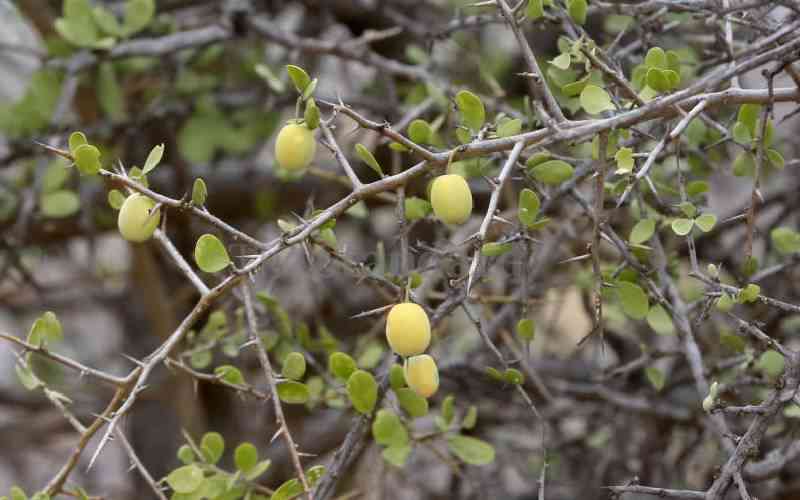Mr John Mureithi came across the thorn melon in his quest to add to the variety of nutritious plants in his farm.
The farmer from Guvuri village, Gatundu South, already had tree tomatoes, capsicum, parsley, turmeric, apples and strawberries in his farm when he heard about the crop’s benefits.
“Many people told me of the diverse health benefits the plant had and kept urging me to supply them with it. I knew of a farmer in Thika who grew kiwano [thorn melon], so I visited him and he told me about the conditions required and supplied me with seedlings,” Mr Mureithi says.
That was in 2012, and he is glad he took the gamble.
Fluctuating prices
“On average, a kiwano sells at between Sh25 and Sh30. The price fluctuates according to supply.”
When demand is high, Mureithi sells a kilogramme of the fruit at Sh90, but when it wanes, he gets Sh70 for the same portion.
“I plant this fruit on a quarter acre and since it is a climbing plant, I prefer planting it close to the wall so it can stretch out,” he says.
The kiwano, so named for its internal similarity to the kiwi fruit, though there is no relation, is best known for its ability to lower high blood pressure, manage diabetes, cardiovascular diseases and obesity, promote healthy eyes and boost immunity.
The fruit is related to cucumbers, pumpkins, courgettes, butternut squash and watermelons as it is from the cucurbitaceae family. It is also known as the jelly or horned melon, or African horned cucumber. Locally, it goes by passion mwitu, parachichi mwitu or passion lenye tete maji.
Maturity period
The thorn melon takes three to four months to mature, according to Mureithi.
“To plant kiwano, I first ensure I have good seeds. I plant these in a seedbed in holes about one foot deep and one foot wide, ensuring the roots do not go too deep. I apply compost manure and the seeds germinate in seven to 10 days,” he says.
Once the crop germinates, Mureithi transplants it into bags or larger trays to provide it with more space and prevent the roots getting tangled as the seedling grows.
“I usually harden the seedlings before they are transplanted to the field by leaving them under a shade for two to three days.”
Stay informed. Subscribe to our newsletter
Once the plant begins to form tendrils, he applies fertilisers, which help the roots develop.
“Farmers can use a compound fertiliser locally known as 1717.”
Mureithi then top dresses the fruit a month after that with Calcium Ammonium Nitrate (CAN), and thereafter, the crop starts flowering.
“I then spray the leaves with folio feed, which contains zinc and potassium.”
According to Mr Gathithu Moka, a farmer in Thika, it is important to keep the soil consistently moist down to about one inch to germinate the crop.
“Ensure you water the horned melon slowly and deeply in the morning or afternoon once it is established. Hand pick the weeds as they appear to prevent diseases like the cucumber mosaic virus.”
The challenges
Mureithi points out that the key challenges facing the growth of the plant is the uncertainty over market prices, and, specific to his farm, a lack of adequate water to irrigate the plant.
The fruit can be eaten by itself, though some people sprinkle salt on the flesh, or as part of a fruit salad. When grilling meat, you can add some thorn melon kernels on top a few minutes before serving it for a tangy highlight. You can also use its kernels in place of a slice of lime in cocktails.
There are communities that boil thorn melon roots to treat gonorrhea, while others boil the leaves and eat them as one would spinach.
According to various researchers, among them the World Health Organisation, thorn melon is a good source of vitamin C, potassium and iron. It also has magnesium, phosphorous, zinc, copper, calcium and sodium, though in smaller quantities.
The seeds of the fruit contain a number of fatty acids, including linoleic acid and oleic acid. Linoleic acid is one of the omega 6 fatty acids with diverse health benefits, such as maintaining brain and nerve function.
Oleic acid, also found in olive oil, is thought to be responsible for the blood pressure-reducing effects of olive oil.
The plant also has two forms of antioxidants — tocopherol and y-tocopherol. Both are organic forms of vitamin E, which aids in giving you glowing, healthy skin and increasing red blood cells. Vitamin E also helps neutralise free radicals that can cause chronic diseases such as cancer.
For more information or contacts, email to [email protected]
 The Standard Group Plc is a
multi-media organization with investments in media platforms spanning newspaper
print operations, television, radio broadcasting, digital and online services. The
Standard Group is recognized as a leading multi-media house in Kenya with a key
influence in matters of national and international interest.
The Standard Group Plc is a
multi-media organization with investments in media platforms spanning newspaper
print operations, television, radio broadcasting, digital and online services. The
Standard Group is recognized as a leading multi-media house in Kenya with a key
influence in matters of national and international interest.
 The Standard Group Plc is a
multi-media organization with investments in media platforms spanning newspaper
print operations, television, radio broadcasting, digital and online services. The
Standard Group is recognized as a leading multi-media house in Kenya with a key
influence in matters of national and international interest.
The Standard Group Plc is a
multi-media organization with investments in media platforms spanning newspaper
print operations, television, radio broadcasting, digital and online services. The
Standard Group is recognized as a leading multi-media house in Kenya with a key
influence in matters of national and international interest.








